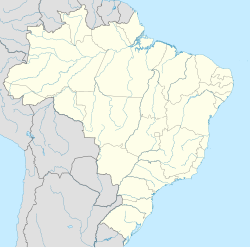Pirassununga is a municipality in the state of São Paulo in Brazil, with an altitude of 627 meters. The population is 76,877 (2020 est.) in an area of 727 km2.[3]
Pirassununga | |
|---|---|
| Municipality of Pirassununga | |
 | |
 Location in São Paulo state | |
| Coordinates: 21°59′46″S 47°25′33″W / 21.99611°S 47.42583°W | |
| Country | |
| Region | Southeast |
| State | |
| Government | |
| • Mayor | Ademir Alvez Lindo (PSDB (2017–2020)) |
| Area | |
| • Total | 727 km2 (281 sq mi) |
| Elevation | 627 m (2,057 ft) |
| Population (2020 [1]) | |
| • Total | 76,877 |
| • Density | 110/km2 (270/sq mi) |
| Time zone | UTC-03:00 (BRT) |
| • Summer (DST) | UTC-02:00 (BRST) |
| Postal code | 13630-000 |
| Area code | (+55) 19 |
| HDI (2010) | 0.801 – very high[2] |
| Website | pirassununga |
Situated in the southeast region of Brazil, the city is home to many important institutions, one being the Brazilian Air Force Academy.[4] All current and future officers of the Brazilian Air Force are trained here. Pirassununga is also home to Fort Anhaguera, which once hosted the 13th Mechanized Cavalry Regiment of the Brazilian army.
In addition to being an important region for the Brazilian military, Pirassununga is a hub for the agriculture and environmental sciences of Brazil. The University of São Paulo's Faculdade de Zootecnia e Engenharia de Alimentos (FZEA), which translates to the College of Animal Science and Food Engineering, is located in the city.[5] Pirassununga is also the location of CEPTA, the National Research and Conservation Center of Continental Aquatic Biodiversity,[6] which is associated with the Chico Mendes Institute, an important research and conservation center in Brasília, the capital of Brazil.
History
editPirassununga was originally home to the Tupi people, an indigenous group in Brazil. They gave the city its name, which means "the sound of fish." Every December, the fish migrate upstream, causing loud sounds as they fight against the current.[7]
Exports
editCachaça
editPirassununga is home to three sugar cane distilleries, Pirassununga 51 Cachaça, Cachaça Sapucaia [8] and Pirassununga Cachaça.[9] The most popular brand, Pirassununga 51 Cachaça, was founded in 1959, just one year after Brazil had won its first FIFA Soccer World Cup.[10] Pirassununga 51 Cachaça became a household name in the country during the 70s. "51, uma boa ideia," which translates to "51, a good idea," soon became a phrase in popular culture.[11] It wasn't until the 1990s that Pirassununga 51 Cachaça became an export to other parts of the world. Cachaça is used as the spirit of choice for Brazil's national cocktail, the caipirinha.[12]
Tourist Spots
editWaterfall Emas
editWaterfall Emas serves as a hydroelectric plant to power the city of Pirassununga. In addition to supplying the city with electricity, it is a local fishing and boating destination. Houses can be rented nearby for fishermen to be near the water. Around Waterfall Emas, one can find many restaurants serving the local fish, dorado.[13]
Media
editIn telecommunications, the city was served by Telecomunicações de São Paulo.[14] In July 1998, this company was acquired by Telefónica, which adopted the Vivo brand in 2012. The company is currently an operator of cell phones, fixed lines, internet (fiber optics/4G) and television (satellite and cable).[15]
Religion
editChristianity is present in the city as follows:
Catholic Church
editThe Catholic church in the municipality is part of the Roman Catholic Diocese of Limeira.[16]
Protestant Church
editThe most diverse evangelical beliefs are present in the city, mainly Pentecostal, including the Assemblies of God in Brazil (the largest evangelical church in the country),[17][18] Christian Congregation in Brazil,[19] among others. These denominations are growing more and more throughout Brazil.
References
edit- ^ IBGE 2020
- ^ "Archived copy" (PDF). United Nations Development Programme (UNDP). Archived from the original (PDF) on July 8, 2014. Retrieved August 1, 2013.
{{cite web}}: CS1 maint: archived copy as title (link) - ^ Instituto Brasileiro de Geografia e Estatística
- ^ "AFA - Academia da Força Aérea". www2.fab.mil.br (in Brazilian Portuguese). Retrieved 2018-11-12.
- ^ "FZEA-USP - FZEA-USP". www.fzea.usp.br. Retrieved 2018-11-12.
- ^ Santos, CEPTA - Fernando. "ICMBio - Centro Nacional de Pesquisa e Conservação de Peixes Continentais - CEPTA - Brazilian Action Plans for freshwater fishes". www.icmbio.gov.br (in Brazilian Portuguese). Retrieved 2018-11-12.
- ^ "História - Prefeitura Municipal de Pirassununga". Prefeitura Municipal de Pirassununga (in Brazilian Portuguese). Retrieved 2018-11-12.
- ^ "Cachaca Sapucaia review". thefatrumpirate.com/sapucaia-florida-ouro. 3 January 2019. Retrieved 2019-01-03.
- ^ "Pirassununga Cachaça - Brazil - review - Ministry of Rum". www.ministryofrum.com. Retrieved 2018-10-22.
- ^ "FIFA". fifa.com. Retrieved 2021-10-11.
- ^ "Cachaça 51". Cachaça 51. Retrieved 2018-10-22.
- ^ "Origem da Caipirinha | Caipirinha Prendada" (in Brazilian Portuguese). Retrieved 2021-10-11.
- ^ "Cachoeira de Emas Pirassununga – Pontos Turisticos, Restaurantes, Hoteis, Turismo, Peixes". cachoeiradeemas.com.br. Retrieved 2018-10-26.
- ^ "Creation of Telesp - April 12, 1973". www.imprensaoficial.com.br (in Portuguese). Retrieved 2024-06-14.
- ^ "Our History - Telefônica RI". Telefônica. Retrieved 2024-06-14.
- ^ "São Paulo (Archdiocese) [Catholic-Hierarchy]". www.catholic-hierarchy.org. Retrieved 2024-06-17.
- ^ "Campos Eclesiásticos". CONFRADESP (in Portuguese). 2018-12-10. Retrieved 2024-06-17.
- ^ "Arquivos: Locais". Assembleia de Deus Belém – Sede (in Portuguese). Retrieved 2024-06-17.
- ^ "Localidade - Congregação Cristã no Brasil". congregacaocristanobrasil.org.br (in Portuguese). Retrieved 2024-06-17.


